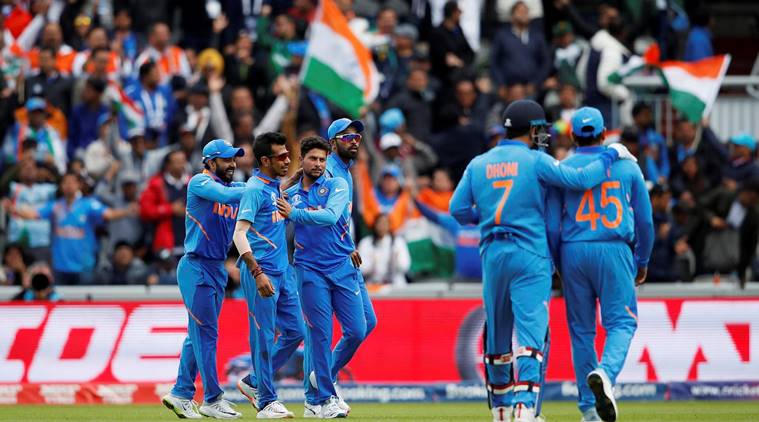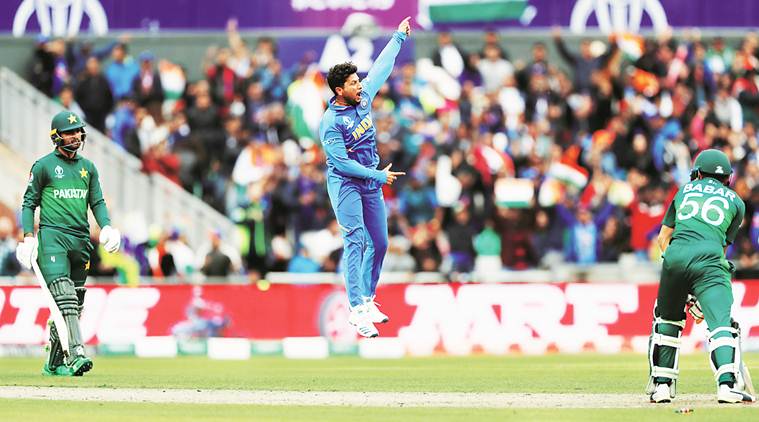A bowler short after Bhuvneshwar Kumar suffered a hamstring strain, all-rounders Hardik Pandya and Vijay Shankar filled in emphatically.
Vijay Shankar (2 for 22) and Hardik Pandya (2 for 40) combined to fulfil the role of a medium-pace all-rounder. (Reuters)
Thank you for reading this post, don't forget to subscribe!In the sixth over of the game, Virat Kohli lost one of his two specialist fast bowlers, Bhuvneshwar Kumar, who was in the middle of a splendrous spell. He is clutching his thighs. But Kohli doesn’t seem to be bothered. He asks Vijay Shankar to loosen up. Shankar bounds in, hardly betraying nerves of a World Cup first-timer, and picks up the wicket of Imam-ul-Haq with his very first ball. Beaming faces abound.
Now imagine a similar sequence play out maybe three years ago. Cue ponderous visages, flapping nerves, lengthy mid-pitch talks, MS Dhoni lost in the characteristic glove on jaw frame.
But here Kohli is chuckling, clapping. Later, he’s informed that Bhuvneshwar has pulled his hamstring so badly that he might miss the entire game. Kohli is upset but not nervous. He needn’t be. He had Hardik Pandya and Vijay.
https://youtu.be/7G7vgUAmPhI
Together, the pair didn’t make Kohli rue the absence of Bhuvneshwar. Among the two, they collected four wickets and conceded only 62 runs in 12.2 overs. If their shifts weren’t spectacular, they certainly were influential in the context of the game.

India celebrate the wicket of Pakistan’s Babar Azam in Manchester on Sunday (Reuters Photo)
For most of his predecessors, this luxury of medium-pace bowling all-rounders, forget two even one, would have been an illusion. His immediate one, MS Dhoni would readily vouch. For much of his tenure, the quest for one was as elusive. It seldom hurt India in the subcontinent, for spin-bowling all-rounders were found in abundance, but the moment they set afoot in pace-bowling friendly conditions, especially in England and Australia, India were repeatedly made to repent the absence of one.
Forget Kapil Dev, those were days India could have wished they had someone of Manoj Prabhakar’s gifts. Instead, even as they cast envious glances on the Watsons and Faulkners of the world, forget the Kallises, they had to content with Laxmi Ratan Shukla, JP Yadav, Stuart Binny, Rishi Dhawan, even Joginder Sharma was projected as a medium-pace bowling all-rounder when he burst forth into international cricket. Barring the seriously talented but mismanaged Irfan Pathan, most of them were forthright pretenders, neither proficient with the ball nor with the bat, like the quintessential bit-part players England used to churn out in the 90s.

Kuldeep Yadav
Dhoni, the skipper for the most part of this decade was forced to include a specialist third seamer several times outside the sub-continent, almost resigned to the fact that India would never really unearth at least a passable all-rounder. “We are always forced to play with a 3-2 bowling combination as we don’t have a genuine all-rounder. It affects the balance, for we always end up with a batsman short, but that’s all we can do,” he’d complained during the last World Cup. And several times before and after that. It was the lone glitch of several otherwise strong Dhoni sides. The missing piece as Dhoni had reiterated several times.
Not any longer. Pandya, has blossomed into indisposable furniture in the side, and it’s a reason he’s sometimes cotton-wooled. Vijay is still largely untested at this level, but furnished an impressive account of himself. Though by accident, Vijay’s inclusion seemed a blessing in hindsight.
Stepping up
Had Shikhar Dhawan not injured his fingers, he would have warmed the benches or ferried drinks, and wouldn’t have strolled in to complete the injured Bhuvneshwar Kumar’s over. Then Kohli would have been left with the only alternative of Pandya. Vijay has been reluctantly used as a bowler, in fairness he’s one-dimensional, endowed with neither pace nor the ability to swing.
But what he lacks in those dimensions, he makes up with his ability to bowl to the field. For Fakhar Zaman, Kohli set an off-side heavy field, for he’s a predominantly a leg-side player. So he usually bowled a good length angling across the left-hander.
Zaman would busily drive, sometimes tap the ball into the gaps or dab through third-man, but he could hardly find the fence. With the run-rate escalating —nudging eight runs — singles didn’t quite hurt. Zaman couldn’t swat him across the line, as he had seen Vijay’s ability to make the ball hold its line, or marginally shape it away, like the delivery that consumed his opening partner Imam-ul-Haq.
To the right-handed Babar Azam, he mostly preyed outside the off-stump, good length, again careful not to gift-wrap deliveries on stumps, silken a leg-side player as he is. That he conceded only two boundaries reflects the stifling channels he probed.
His discipline also meant that he could hold Pandya back a little. Pandya was summoned when Kohli generally summons him, around the ninth over. These days, Pandya plies his trade on auto-pilot mode, he knows his role, the lengths he needed to hit and the lines he needed to persist.
He mostly plugged back-of-length, striving for the extra bounce that his whippy action enables. One such delivery nailed Shoaib Malik for a first-ball zero, and with him blew Pakistan’s last lingering hopes of salvaging an improbable comeback.
In the end, the dazzle of Rohit Sharma and razzle of Kuldeep’s magic balls will outshine the labour of the two pace all rounders. But Kohli would certainly appreciate the collective as well as individual value of Pandya and Vijay.



